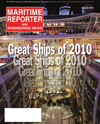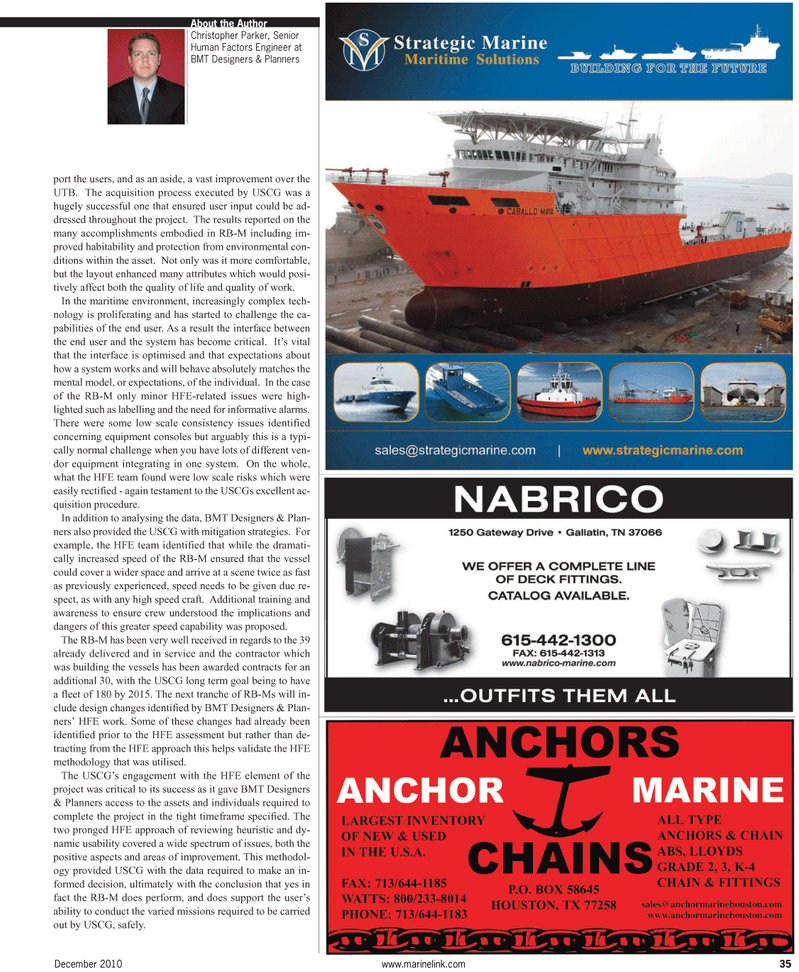
Page 35: of Maritime Reporter Magazine (December 2010)
Great Ships of 2010
Read this page in Pdf, Flash or Html5 edition of December 2010 Maritime Reporter Magazine
port the users, and as an aside, a vast improvement over the
UTB. The acquisition process executed by USCG was a hugely successful one that ensured user input could be ad- dressed throughout the project. The results reported on the many accomplishments embodied in RB-M including im- proved habitability and protection from environmental con- ditions within the asset. Not only was it more comfortable, but the layout enhanced many attributes which would posi- tively affect both the quality of life and quality of work.
In the maritime environment, increasingly complex tech- nology is proliferating and has started to challenge the ca- pabilities of the end user. As a result the interface between the end user and the system has become critical. It’s vital that the interface is optimised and that expectations about how a system works and will behave absolutely matches the mental model, or expectations, of the individual. In the case of the RB-M only minor HFE-related issues were high- lighted such as labelling and the need for informative alarms.
There were some low scale consistency issues identified concerning equipment consoles but arguably this is a typi- cally normal challenge when you have lots of different ven- dor equipment integrating in one system. On the whole, what the HFE team found were low scale risks which were easily rectified - again testament to the USCGs excellent ac- quisition procedure.
In addition to analysing the data, BMT Designers & Plan- ners also provided the USCG with mitigation strategies. For example, the HFE team identified that while the dramati- cally increased speed of the RB-M ensured that the vessel could cover a wider space and arrive at a scene twice as fast as previously experienced, speed needs to be given due re- spect, as with any high speed craft. Additional training and awareness to ensure crew understood the implications and dangers of this greater speed capability was proposed.
The RB-M has been very well received in regards to the 39 already delivered and in service and the contractor which was building the vessels has been awarded contracts for an additional 30, with the USCG long term goal being to have a fleet of 180 by 2015. The next tranche of RB-Ms will in- clude design changes identified by BMT Designers & Plan- ners’ HFE work. Some of these changes had already been identified prior to the HFE assessment but rather than de- tracting from the HFE approach this helps validate the HFE methodology that was utilised.
The USCG’s engagement with the HFE element of the project was critical to its success as it gave BMT Designers & Planners access to the assets and individuals required to complete the project in the tight timeframe specified. The two pronged HFE approach of reviewing heuristic and dy- namic usability covered a wide spectrum of issues, both the positive aspects and areas of improvement. This methodol- ogy provided USCG with the data required to make an in- formed decision, ultimately with the conclusion that yes in fact the RB-M does perform, and does support the user’s ability to conduct the varied missions required to be carried out by USCG, safely.
December 2010 www.marinelink.com 35
About the Author
Christopher Parker, Senior
Human Factors Engineer at
BMT Designers & Planners

 34
34

 36
36
